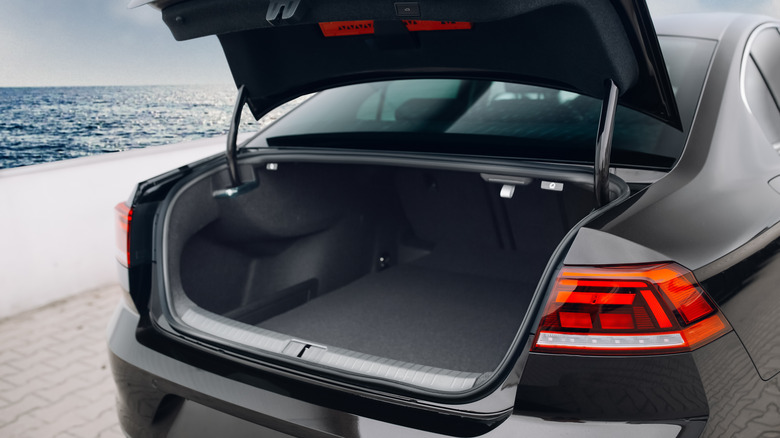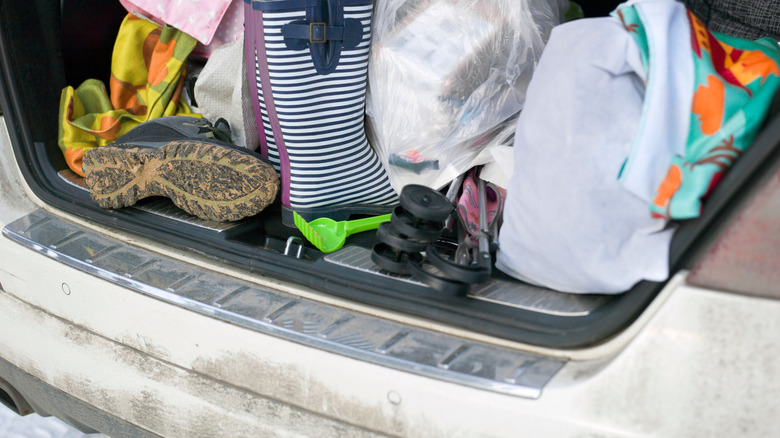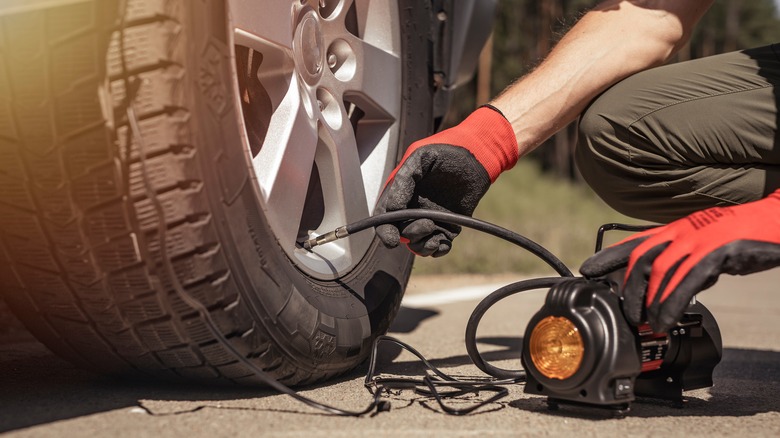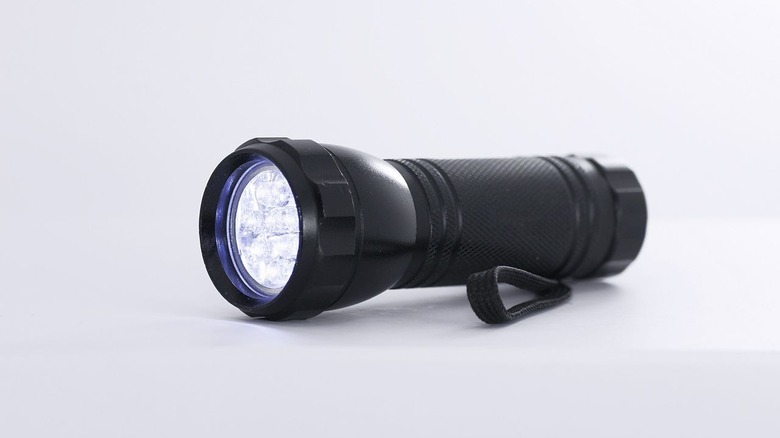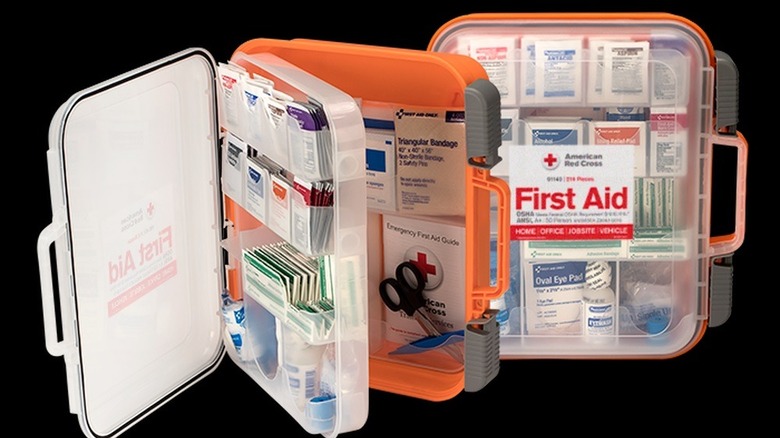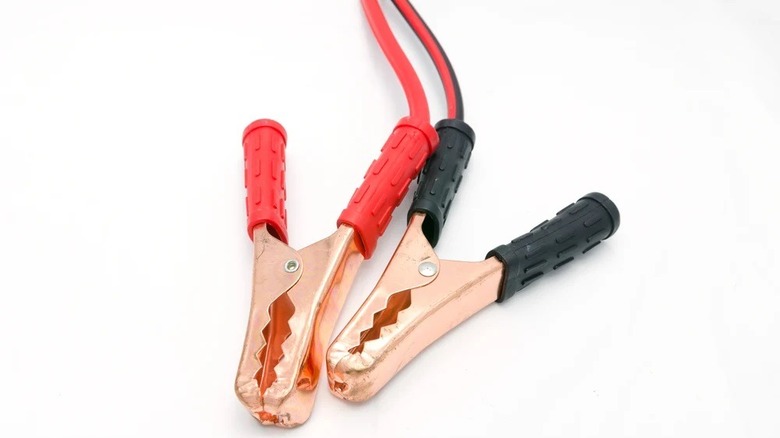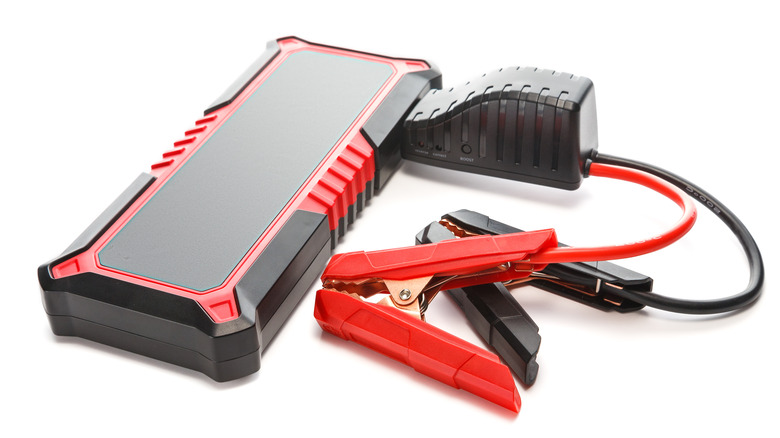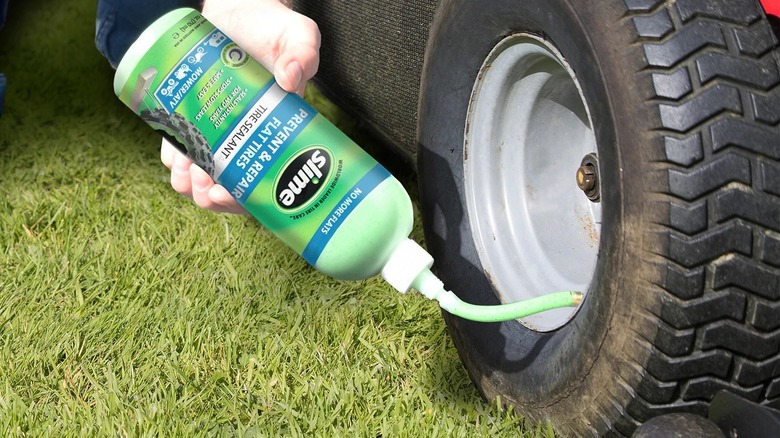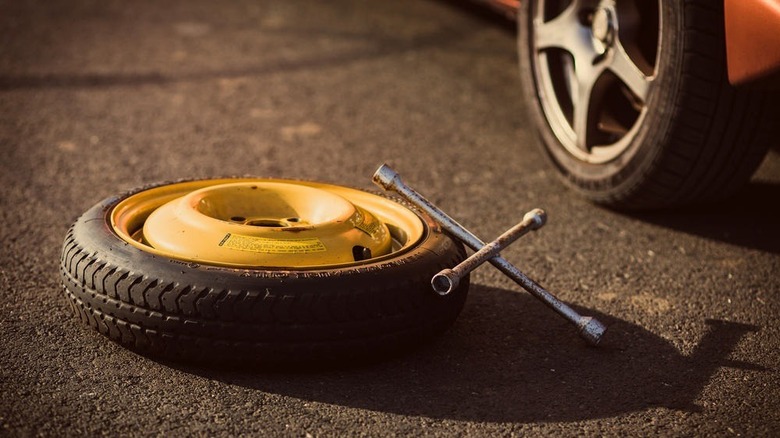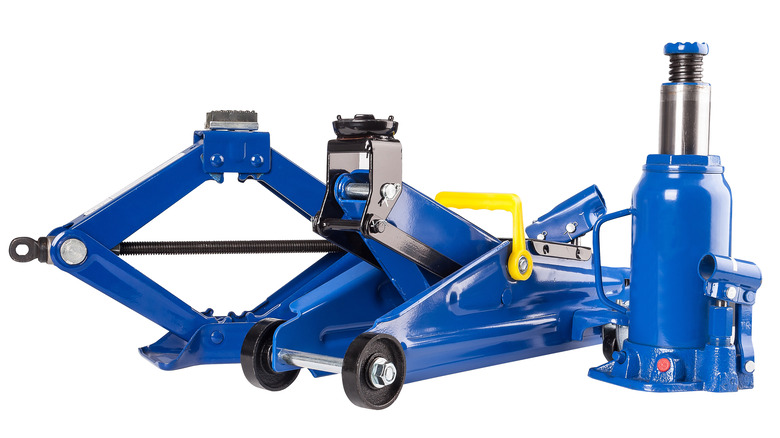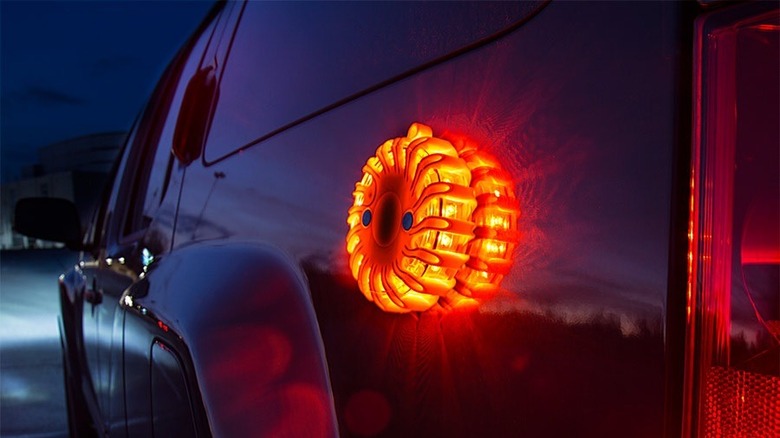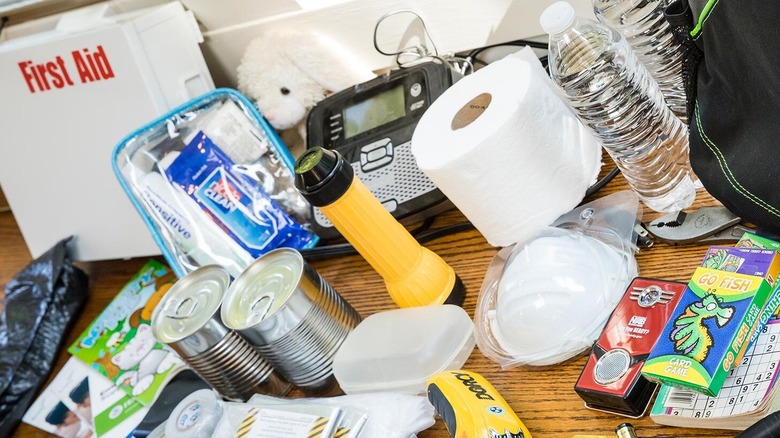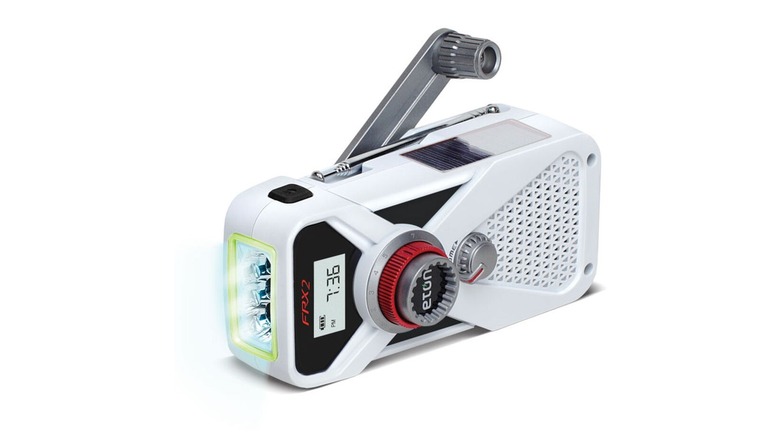13 Important Things Every Car Owner Should Keep In Their Trunk
It's likely that you don't often think about the trunk of your car — out of sight, out of mind. They have a way of gathering junk that you swear you're going to get rid of just as soon as you get home, and then it's forgotten forever. Or at least until you go to store something and realize you're about to be buried in a mountain of empty windshield wiper fluid containers.
Your trunk, however, doesn't have to be a magnet for detritus. You can turn it into a crucial and useful storage area filled with things you'll actually use. If used correctly, your trunk can make your driving experience much more convenient and a whole lot safer.
In addition to coolant and an ice scraper, here are twelve things we think every driver should keep in the trunk of your car. Hopefully, you won't be called upon to use most of these any time soon, but if you are, you'll be glad they were there.
A good trunk organizer
Before we fill your trunk with all of its new goodies, we need to get out of the junk mentality. The first part is on you. Stop by a dumpster and toss out all the stuff that's collected in there.
Now that's it's clean, you're going to need a trunk organizer. Even a well-stocked trunk has a tendency to get messy as you're driving around. Every time you hit a bump or take a turn too fast, everything in there is going to slide around and mix together, making it difficult for you to find what you need when you need it. A good trunk organizer keeps all of the necessities right where you left them and leaves the rest of your trunk space available for hauling groceries or carting home whatever family heirlooms your parents thrust upon you when you go for a visit.
There are plenty of options, from rigid and sturdy box designs to hanging organizers with sections and pockets. At the very least, it can keep your car fluids from tipping over and getting onto the rest of your belongings.
Electric tire inflator
Have you ever woken up in the morning to discover that your tire is too low to drive on, or totally flat? It always seems to happen at the worst possible time, when you're already running late and don't have the time to deal with an automotive emergency.
Having a slow leak can be especially frustrating and might even strand you for a while. Worse, unless you have the time and resources to get it repaired right away, once you refill the tire the leak just starts again.
If your tire is totally flat you've got a couple of options. You can remove the tire and roll it down the street to the nearest public air pump or call a friend to help you out. An electric inflation device solves the problem for you without having to call upon your friends or roll a flat tire a mile down the road.
They're relatively affordable and easy to use. Just plug it into your car's charge port (formerly known as a cigarette lighter), connect it to the tire's air intake, set the psi, and wait for the tire to fill up with air.
Water resistant flashlight
When we get into our car, we hope and expect to get where we're going quickly and safely, and most of the time that's what happens. It's likely, however, that at some point in your life you're going to end up stuck on the side of the road. Because the universe likes to play games, it'll probably be in the dark and while it's raining.
Fixing a flat or checking your engine in the dark is a nightmare, being stuck in the rain only makes it worse. Having a good flashlight in your trunk won't stop the rain from falling but it will minimize the amount of time your outside in the downpour.
A solid waterproof flashlight will ensure you don't lose your source of light while looking for lost items, inspecting your car for a solution, or signaling for help. Some of them are even rated to continue working several feet underwater for up to half an hour. So, if you ever accidentally drive into a lake, you'll at least be able to see your surroundings.
First aid kit
When you're at home you have access to all of the bandages, ointments, and medicines you might need to treat your minor medical needs. When you get into your car, however, you leave all of that behind.
You never know when you might be called upon to administer basic first aid to yourself, a loved one, or a total stranger. Moreover, long road trips can sometimes leave you at a distance from professional medical help, and it's best to be prepared. Not to mention, working with cars tends to involve at least a few minor cuts and scrapes as you squeeze your hands into tight spaces or work a wrench near rough road pavement.
Any decent first aid kit will include pads to stop bleeding, bandages, ointments, and probably some low-level pain medications. That's enough to get you out of most of the scrapes you're likely to encounter on the road, but car-specific first aid kits often come with additional supplies like collapsible shovels or two straps, which can be helpful on the road.
Jumper cables
It's happened to all of us. You're out and about, ready to head to your next destination or back home for the night, and your car won't start. You turn the key and hear the telltale click of a dead battery. Whether you left on an overhead light or used up too much juice at the drive-in, a dead batter is an annoying but easily remedied problem as long as you have the right tools.
Luckily, a drained battery just needs a little help to get going again before your alternator can take over. Borrowing power from another battery is a quick and easy solution, but without cables to drink that power up, there's nothing you can do.
Keeping a good pair of jumper cables handy ensures you don't have to worry about getting stranded and it also means you can help other people when the need arises. They're totally affordable and well worth the investment to save you from a hassle down the road. Plus, every time you use them you get the lizard brain satisfaction of giving them a clack-clack on the way to the hood. Worth it.
Portable jump starter
Jumper cables are a great solution for most battery related problems. It's likely that most of the places you're going have other people nearby who can help you out in a bind. That said, there are times when you're on your own to find a solution.
Maybe you're at home during the day and all the neighbors are at work. Maybe it was a long day at the office and yours is the only car in the lot. Or maybe you're just socially averse and want to avoid unnecessarily talking to strangers. Honestly, we get it. An automatic jump starting device is the perfect solution.
These kits come with a large external battery connected to a pair of jumper cables and can typically hold a charge for up to a year or longer. Tossing one in your trunk (gently, it is a big battery after all) and forgetting about it is a guarantee that you'll never have to worry about a dead battery again.
In addition to jump starting your car, many of these kits can also be used for other vehicles like boats or ATVs and some even come with USB or 12-volt outlets for charging whatever needs charging.
Tire sealant
Your electric inflation tool is a great solution for a slow leak, but it won't be of much help if you've got a larger puncture in your tire, at least not until you get it closed up. The road is full of hazards including unsafe drivers and crossing animals, but at least you can see those obstacles and make efforts to avoid them. Loose screws, nails, or broken glass are harder to see but potentially just as dangerous.
A flat tire could leave you stuck on the side of the road, and nobody wants the unexpected expense of calling a tow truck just to get them back to town. All of that can be avoided with a simple can of tire sealant. There are a number of different kinds, but they all work in relatively similar ways.
A viscous liquid carrying solid particles enters the tire through the air intake and those particles plug up the hole, (per Slime). As long as the puncture isn't too big, tire sealant can fix a leak and get you back on the road. Some types of sealant require you to squeeze the liquid into the tire while others are pressurized and do the work for you. No matter the type, the result is the same.
Tire sealant isn't a permanent solution to a punctured tire, and you should still visit a shop to have the tire inspected and repaired, but it will make an undesirable situation a lot easier to manage.
A spare tire
What about when the damage to your tire is too much for the inflating tool and sealant to handle? If the puncture or tear is larger than about a quarter of an inch, it's likely sealant won't be able to plug it up and your electric inflator is just going to be pushing air around. The best solution here is a whole new tire.
If you bought your car new, there's a good chance it came with a spare and you're all set. If you don't have one, however, or if the one you have is worn down from previous use, it's a smart thing to get.
A full-sized spare matching your car's tires is ideal, but it can be pricey buying an extra tire and the rim for it to sit on. Luckily, there's a more affordable solution. A compact spare, more commonly known as a donut tire, takes up less space and is more than serviceable for getting you back on the road.
They are limited in terms of speed and distance. Following the 50/50—don't travel faster than 50 mph, and don't go farther than 50 miles—will keep you safe, (per AAA).
Jack and wrench kit
Having a spare tire when you need it is all well and good, but it won't be much help if you can't remove the flat and replace it. Being capable of changing a tire is a skill everyone should know, it's relatively simple, doesn't take specialized education, and only takes a few minutes. Before you can do any of that, you're going to need a solid jack and a tire wrench.
There are a ton of options from higher end electric or pneumatic scissor jacks and hydraulic lifts to simple turn crank jacks that rely on elbow grease to lift your car off the ground. The general rule is, the more work you have to do physically, the cheaper your kit is going to be. Honestly, though, your jack and wrench don't need to be fancy, they just need to get the job done.
A kit with everything you need to lift your car and remove the tire can be found for about $25.00 at the low end, and everything will tuck together nicely in a small carrying case for easy storage.
LED road flares
Being stuck on the side of the road, even when you have the situation well in hand, has the potential to be dangerous. When visibility is low, the potential for accidents involving other drivers who don't see you is much higher.
A set of reflective triangles or road flares are crucial for making sure other drivers see you when it's dark out. Not only will it protect you and your passengers from any accidental collisions, but it can also alert passersby that you might be in need of assistance.
A simple reflective material can get the job done in a pinch, but LED road flares are next level. Varying models can be set up as shining pylons on the road nearby, or they can attach to the car itself using hooks or magnets. In addition to alerting others to your presence, they'll also help illuminate your worksite and battery life can last for hours or day. Hopefully you won't be stuck on the roadside that long.
Kitty litter
This trunk addition might sound a little out of left field, but it can be really useful, especially if you live in a colder part of the world. Standard kitty litter is made almost entirely out of clay, (per Made How), which makes it good for soaking up your cat's waste, but those same properties can have several automotive uses.
Kitty litter is great at picking up spills, like used motor oil. If you're doing oil changes in your driveway, or just have a minor oil leak, spreading some kitty litter can prevent it from getting all over the concrete. At home use doesn't require keeping the litter in your trunk, but it doesn't hurt.
You will want to keep some in your trunk, however, for driving in ice and snow. When it comes to situations you don't want to get stuck in, a snowstorm is pretty close to the top of the list. Kitty litter is great for giving you the little bit of extra traction you might need to get out of a snowdrift, (per Asking Lot).
Dig out as much of the snow as you can, then spread kitty litter behind and in front of your tires and press the accelerator. Fingers crossed, you'll be out of there in no time.
72-hour survival kit
With any luck you'll never end up stranded away from home for more than a few hours, but if you do, having a 72-hour survival kit could make all the difference. This is one of the more expensive items on the list, but it might be one of the most important.
Survival kits are about as varied as the situations which might call for them but each of them comes with some standard supplies. Depending on the kit you choose, they should have enough food and water for one person, two people, or a larger family. Other common items include gloves, breathing masks, small first aid kits, flares, flashlights, and basic tools.
These can get pretty pricey but, depending on the kit you choose, you might be able to cover several of the other items on this list. These are also one of those items you'll hopefully only have to buy once. The food inside can last years or months and can be replaced once it's near its expiration date without having to replace the entire kit.
Once it's in your trunk you won't have to think about it again, and if push comes to shove you can always eat the aging food in lieu of snacks on your next road trip.
Hand crank radio
What's a road trip without tunes? You probably have a car stereo for most of your audio needs, but a small handheld radio is still a good addition to your trunk essentials. If you enjoy camping or hiding and like to take audio with you, then you might get pretty consistent usage out of a handheld radio.
Where they really shine (sometimes literally, more on that in a minute) is an emergency situation. A good handheld radio will pick up any AM or FM frequencies in your area and some are designed for specifically picking up the National Weather Service and alerting you to any inclement weather events. Many emergency radios have additional features built in, like a whistle and a flashlight, both of which can be useful if you're stranded far from home.
We recommend one with solar panels or a hand crank for charging. The energy in disposable batteries is limited, but a hand crank will keep your radio powered up as long as you're willing to turn the dynamo every now and again. Certain models even let you charge your phone or other portable devices from the internal battery. Being able to keep your phone charged with a hand crank is reason enough to get one.
